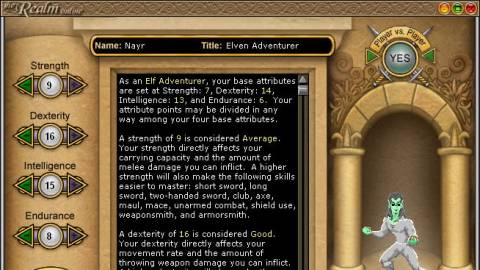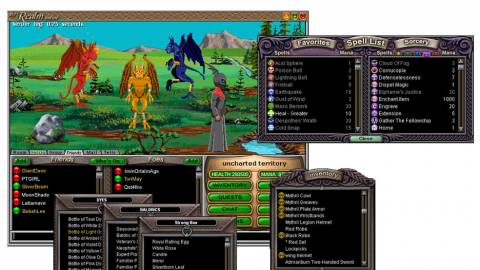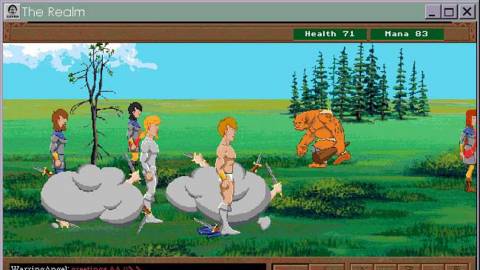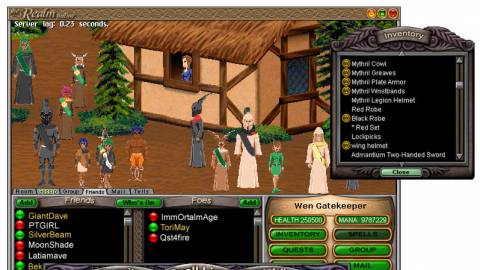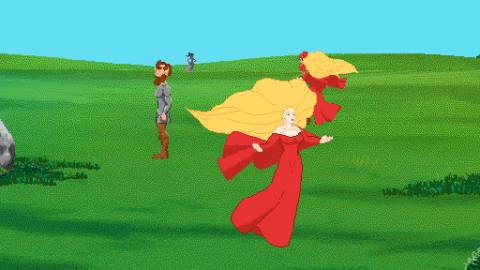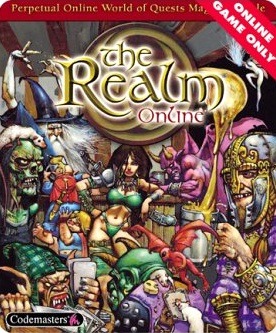Overview
The Realm claims the title of the world's longest-running MMO RPG. It was released in March of 1995 by Sierra Online, and the game has been in service since its initial release. It borrows both graphically and in terms of interface from King's Quest VII, another Sierra release from roughly the same time-frame. In the time since its launch, the game was sold first to Codemasters then to Norseman Games and is now developed and operated by Rat Labs, LLC under license from Norseman Games.
Gameplay
Many of the gameplay conventions were borrowed from Sierra's point-and-click adventure games. Movement is accomplished by simply clicking on the desired destination. The game is divided into "screens" through which the player advances by clicking any of the four edges of the current screen. The character will then walk to that edge and a new screen will appear. Combat is initiated by clicking on a mob which will then load a special combat screen. After combat is complete, the character is returned to the previous screen. In addition to the influence of the point-and-click adventure, the game has many of the tropes of modern MMOs albeit in a very basic form. There are shops, spells, quests, character houses, and crafting.
Early MMO Stylings
Due to the graphical limitations, characters in the realm were depicted as wearing clothing. The articles of clothing were considered armor, but the only differentiating factor between any armor was color. Helmets were implemented late in the game's cycle.
Today's MMO's generally show you a character's level when you view a character. Viewing a character on screen or a character's profile in The Realm did not show what level they were. The only surefire way to show a character's level was the wearing of different colored baldrics. Baldrics, nicknamed "baldies" in game, became available for purchase and wearing as the character achieved higher levels. Certain color baldrics had a level requirement while others did not. If a character was wearing a blue baldric, for example, they were at least level 3. It was not a very efficient system.
A key feature of The Realm that is absent in many other MMORPGs is the inclusion of a house with every created character. NPCs known as "Gatekeepers" were placed in each city by which the character could type in a character's name and be transported to their house. Each character's house consists of three screens: the front yard, the living area, and the bedroom. The door to the house was password protected, as was the treasure chest in the bedroom. Characters did not sleep, so the house functioned simply as a place to store items and as starting place when the player logged in. Characters often would have guild parties at members' homes and the occasion often called for special decoration by laying items such as flowers, baubles, bread, etc. on the floor in a decorative pattern.
As The Realm was one of the first MMORPGs, it did not have many of the features standard in MMORPGS today. The Realm did not have many built-in security measures to prevent scamming by some of the more creative members of the community. Both the house and the chest in the bedroom were password protected. Because the only way to go to a character's house was to type their name at the Gatekeeper, characters would often leave one or the other unlocked. Resourceful and less moral players, however, could loiter near the Gatekeeper and follow after a character as they return home. The burgling player could then wait behind plants in the front yard and make themselves hidden to the home owner. After a few minutes the home owner would either leave again or had already logged out. As this method was not well known, the door and chest were often left unlocked, and the burgling character was free to help themselves to whatever goods and treasures were inside. Eventually an "EVICT" button was implemented that would immediately kick out any and all guests.
There also was no official trade system. Characters would have to physically give the object to the trading character or drop them on the ground for them to pick up. A middle man system was developed in the community where the two parties would hire a go-between to facilitate the trade. Trader 1 would give their item to the middle man, then trader 2 would give the gold (as was often the case). The middle man would perform the trade and would often be tipped for his/her service. High-stakes trades often demanded well-known and respected middle men.
Enterprising players frequently abused the system. They would often work in tandem. Both players would create alternate characters. As there was no way to view a character's level, as long as the two characters were not in the starting clothing, known as "newbie grays," there was no way to tell them from established characters. One of the players would advertise in the trade chat channel that they wanted to either purchase or sell a high-priced item. Early on the most valuable item was a Wrath (rare two-handed sword) with all four available enchantments. Once a mark was found, they would agree to a meeting place and the other player would act as the middle man. The scamming player would give the middle man something of little worth, i.e. one piece of gold or a loaf of bread. Due to the graphical limitations, the victim would see that something was given, but it did not animate what was traded. The unsuspecting player would then give the valuable item. Once the middle man scammer verified that it was indeed the agreed upon item, they would immediately disconnect their connection or simply walk away. For a more theatrical effect the first scammer could feign anger that they too got duped, but it was often easier to simply disconnect or walk away themselves. After several minutes the two players would meet up divide the gold or items, transfer them to their main characters, then delete both scam characters. As The Realm did not have a standard system of Game Moderators, there was more or less nothing the scammed player could do except be more careful and use known traders in the future.
System Requirements
Pentium 166, 100MB hard disk, Internet access, 32MB RAM, Windows 95, 16-bit color

 PC
PC


